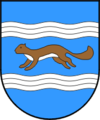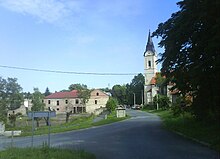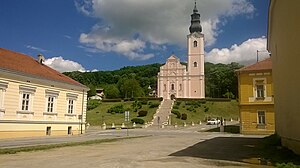Pakrac
| Pakrac | ||
|
||
|
|
||
| Basic data | ||
|---|---|---|
| State : |
|
|
| County : |
|
|
| Height : | 165 m. i. J. | |
| Area : | 358.08 km² | |
| Residents : | 8,460 (2011) | |
| Population density : | 24 inhabitants per km² | |
| Telephone code : | (+385) 034 | |
| Postal code : | 34 550 | |
| License plate : | PŽ | |
| Structure and administration (status: 2013, cf. ) |
||
| Community type : | city | |
| Mayor : | Before Huška ( HDZ ) | |
| Website : | ||
Pakrac [ ˈpakrats ] ( German obsolete Pakratz ) is a city in Croatia .
Geographical location
Pakrac is located in a valley in the Požega-Slavonia County , 165 m above sea level. The Pakra flows through the center of the city, dividing the city into a left-hand and a right-hand urban area.
population
During the last census (2011) the city had 8,460 inhabitants.
Many villages in the west were mostly inhabited by Serbs before the war and were held by them from 1991 to 1995 during the Croatian War . Pakrac remained in Croatian hands during this time and was fiercely contested as a frontline town, with many historical buildings being badly damaged. In 1995, the villages and forests occupied by the Serbs were finally captured by Operation Bljesak (Blitz) of the Croatian army, which was supported by Croatian police units.
Before the war, the Serbs were the largest population group with over 40%, followed by Croats with a little under 40% and some minorities.
Today the Croatians are the largest population group: 72.9%. There are also Serbs (15.8%), Italians (4.8%), Czechs and Hungarians.
history
The first secure historical mention comes from the year 1237 and reports of a settlement of crusaders ( Templars ) called Pekriz at that time , which was later (~ 1312) taken by Ivanovcen ( Johannitern ).
In the middle of the 16th century, Slavonia was conquered by the Ottomans. In 1538 the Sanjak Požega and then, in 1557, the Sanjak Pakrac was founded. Thus Pakrac remained part of the Ottoman Eyalet Bosnia until the Peace of Karlowitz (1699) - after which it fell back to the Habsburgs .
Infrastructure
The city has a kindergarten, elementary and middle school, music school as well as a public library and several sports clubs. The clinic, which opened for the first time in 1760, currently has 86 beds and supplies not only the residents of Pakrac but also the population of the surrounding area.
The main economic pillars are agriculture and forestry as well as the industrial production of building materials .
To the transport network Pakrac is, inter alia, by a trunk road ( Novska - Lipik -Pakrac- Daruvar - Virovitica and a) railroad track ( Banova Jaruga connected -Lipik-Pakrac-Daruvar-Virovitica) and a plurality of bus lines.
Monuments and landmarks
- The Catholic Church of the Assumption of Mary Uznesenja Blažene Djevice Marije (was badly damaged by Serbian separatists during the Croatian War and was subsequently repaired.)
- The Serbian Orthodox Trinity Cathedral : was also badly damaged
- Baron Trenk's barracks (Vojarna bruna Trenka)
- The Janković Family Complex (Kompleks zgrada obitelji Janković)
- David Pick's Jewish residence
- The Spahi cellar (Spahijski podrum)
- The Serbian Orthodox Bishopric
- The old town hall (Stara gradska vijećnica)
- The city museum
- The monument to Franjo Tuđman
Personalities
- Smilja Avramov (1918–2018), legal scholar
- Milan Horvat (1919–2014), Austrian conductor
- Zdravko Luburić (* 1942), writer
- Jadranka Kosor (* 1953), politician and journalist
- Josef Kovač (* 1953), German businessman, non-fiction author, publisher and university lecturer
- Zoran Erceg (* 1985), Serbian basketball player
literature
- Fazileta Hafizović, Širenje islama u požeškom i pakračkom sandžaku, Fehim Nametak (ed.), Širenje islama i islamska kultura u bosanskom ejaletu, Prilozi za orijentalnu filologiju, vol. 41, Sarajevo 1991, p. 75.
Web links
- City website (hr)



